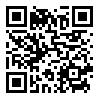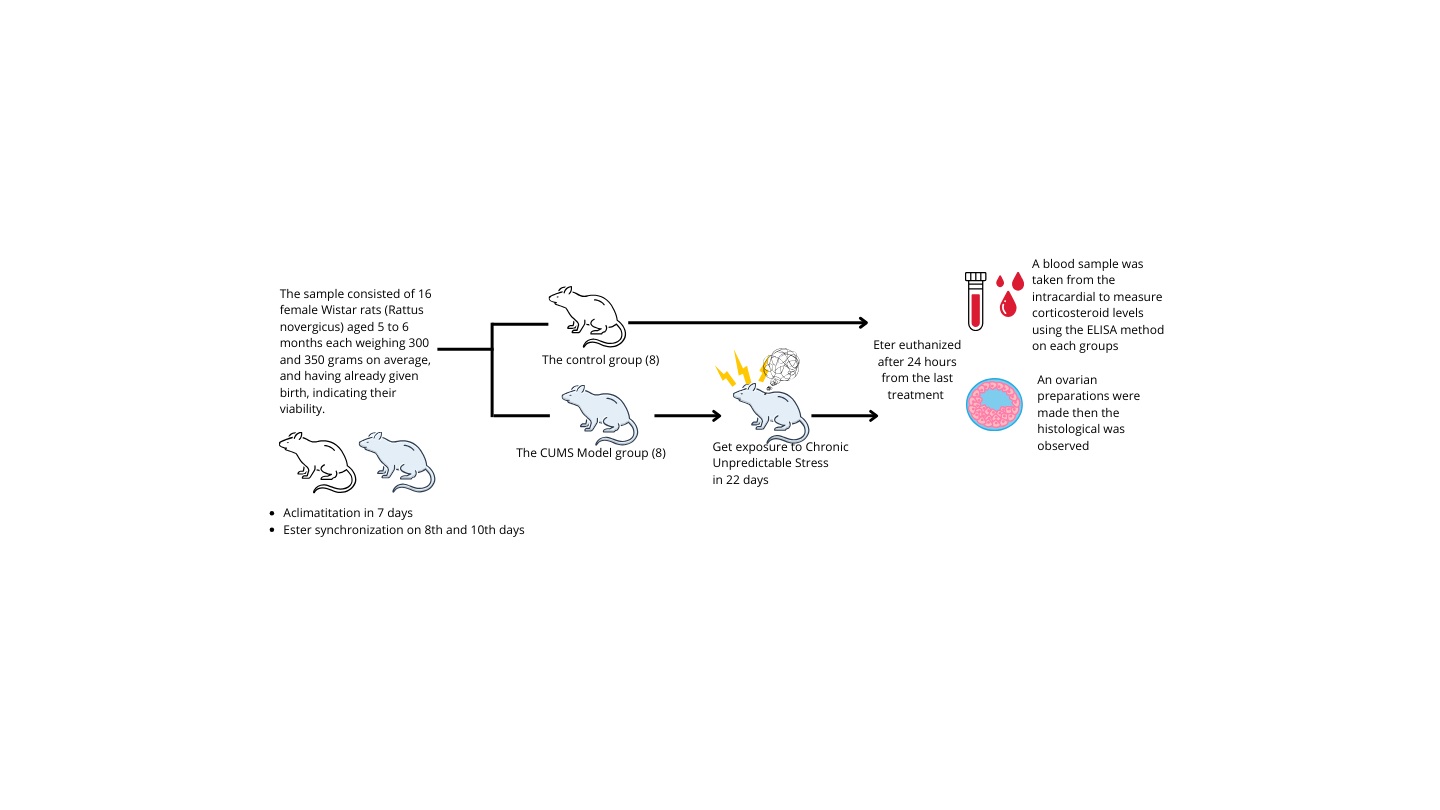Mon, Dec 8, 2025
[Archive]
Volume 23, Issue 4 (April 2025)
IJRM 2025, 23(4): 303-312 |
Back to browse issues page
Ethics code: 2.KEH.54.03.2018
Download citation:
BibTeX | RIS | EndNote | Medlars | ProCite | Reference Manager | RefWorks
Send citation to:



BibTeX | RIS | EndNote | Medlars | ProCite | Reference Manager | RefWorks
Send citation to:
Puriastuti A C, Maramis M M, Annas J Y, I’tishom R, Srirejeki P, Sulistiawati. How does chronic unpredictable mild stress affect the number of mature oocytes? An experimental study. IJRM 2025; 23 (4) :303-312
URL: http://ijrm.ir/article-1-3316-en.html
URL: http://ijrm.ir/article-1-3316-en.html
Alifia Candra Puriastuti *1 

 , Margarita Maria Maramis2
, Margarita Maria Maramis2 

 , Jimmy Yanuar Annas3
, Jimmy Yanuar Annas3 

 , Reny I’tishom4
, Reny I’tishom4 

 , Purwo Srirejeki5
, Purwo Srirejeki5 

 , Sulistiawati6
, Sulistiawati6 




 , Margarita Maria Maramis2
, Margarita Maria Maramis2 

 , Jimmy Yanuar Annas3
, Jimmy Yanuar Annas3 

 , Reny I’tishom4
, Reny I’tishom4 

 , Purwo Srirejeki5
, Purwo Srirejeki5 

 , Sulistiawati6
, Sulistiawati6 


1- Midwifery Department, Faculty of Medicine, State University of Malang, Jalan Semarang No. 5, Malang, Indonesia. & Reproductive Health Science, Postgraduate Programme, Medical Faculty, Jalan Prof. Dr. Moestopo No. 47, Universitas Airlangga Surabaya, Indonesia. , alifia.candra.fik@um.ac.id
2- Division of Biological Psychiatry and Neuroscience, Faculty of Medicine Airlangga University, Medical Faculty, Jalan Prof. Dr. Moestopo No. 47, Universitas Airlangga, Surabaya, Indonesia.
3- Department of Obstetrics and Gynecology, Medical Faculty, Universitas Airlangga, Jalan Prof. Dr. Moestopo No. 47, Surabaya, Indonesia.
4- Department of Biomedical Science, Medical Faculty, Universitas Airlangga, Jalan Prof. Dr. Moestopo No. 47, Surabaya, Indonesia.
5- Department of Medical Physiology, Medical Faculty, Universitas Airlangga, Jalan Prof. Dr. Moestopo No. 47, Surabaya, Indonesia.
6- Department of of IKM-KP, Medical Faculty, Universitas Airlangga, Jalan Prof. Dr. Moestopo No. 47, Surabaya, Indonesia.
2- Division of Biological Psychiatry and Neuroscience, Faculty of Medicine Airlangga University, Medical Faculty, Jalan Prof. Dr. Moestopo No. 47, Universitas Airlangga, Surabaya, Indonesia.
3- Department of Obstetrics and Gynecology, Medical Faculty, Universitas Airlangga, Jalan Prof. Dr. Moestopo No. 47, Surabaya, Indonesia.
4- Department of Biomedical Science, Medical Faculty, Universitas Airlangga, Jalan Prof. Dr. Moestopo No. 47, Surabaya, Indonesia.
5- Department of Medical Physiology, Medical Faculty, Universitas Airlangga, Jalan Prof. Dr. Moestopo No. 47, Surabaya, Indonesia.
6- Department of of IKM-KP, Medical Faculty, Universitas Airlangga, Jalan Prof. Dr. Moestopo No. 47, Surabaya, Indonesia.
Abstract: (823 Views)
Background: The chronic unpredictable mild stress (CUMS) model involves applying mild stressors over a prolonged period, that can induce oxidative stress. Oxidative stress disrupts normal cellular functions, leading to reduced survival of antral follicles through increased glucocorticoids.
Objective: This study aims to identify the effect of stress on the regulation of glucocorticoid hormones and its impact on impaired antral follicles. Specifically, it focuses on the number of antral follicles using the CUMS model in female rats.
Materials and Methods: 16 female Wistar rats (5-6 months, 300-350 gr) were divided into 2 groups (n = 8/each), the control and the CUMS model. 24 hr after the last treatment, they were eter euthanized, a blood sample was taken from the intracardial to measure corticosteroid levels using the enzyme-linked immunoassay (ELISA) method, ovarian preparations were made, and then the histological sections were observed.
Results: After 22 days of CUMS, a significant difference was observed in corticosterone levels (p = 0.03), but no significant difference was observed in the number of antral follicles between the 2 groups (p = 0.57). However, histological analysis indicated substantial differences. The control group’s ovaries exhibited a higher proportion of healthy antral follicles.
Conclusion: CUMS increases glucocorticoids, which in turn causes a decrease in the number of antral follicles. This happens through 2 mechanisms: suppression of gonadotrophin-releasing hormone and direct effects on the ovaries that elevate granulosa cell apoptosis and follicular atresia, ultimately leading to a reduction in antral follicles.
Objective: This study aims to identify the effect of stress on the regulation of glucocorticoid hormones and its impact on impaired antral follicles. Specifically, it focuses on the number of antral follicles using the CUMS model in female rats.
Materials and Methods: 16 female Wistar rats (5-6 months, 300-350 gr) were divided into 2 groups (n = 8/each), the control and the CUMS model. 24 hr after the last treatment, they were eter euthanized, a blood sample was taken from the intracardial to measure corticosteroid levels using the enzyme-linked immunoassay (ELISA) method, ovarian preparations were made, and then the histological sections were observed.
Results: After 22 days of CUMS, a significant difference was observed in corticosterone levels (p = 0.03), but no significant difference was observed in the number of antral follicles between the 2 groups (p = 0.57). However, histological analysis indicated substantial differences. The control group’s ovaries exhibited a higher proportion of healthy antral follicles.
Conclusion: CUMS increases glucocorticoids, which in turn causes a decrease in the number of antral follicles. This happens through 2 mechanisms: suppression of gonadotrophin-releasing hormone and direct effects on the ovaries that elevate granulosa cell apoptosis and follicular atresia, ultimately leading to a reduction in antral follicles.
Type of Study: Original Article |
Subject:
Reproductive Psycology
Send email to the article author
| Rights and permissions | |
 |
This work is licensed under a Creative Commons Attribution-NonCommercial 4.0 International License. |





